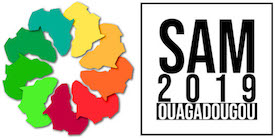Dan  Zook of ISF Advisors opened the SAM session on “Fostering Economic Resilience in the Face of Climate Change” arguing that smallholder farmers are the “number one most vulnerable in the world to climate change…so it’s important that we talk about adaptation financing.” A survey by CGAP segments the needs of farmers as follows: (1) subsistence farmers are the poorest and most vulnerable; they need savings and insurance; (2) commercial farmers that sell cash crops can benefit from investments such as drip irrigation; and (3) larger-scale farmers need to think about adaptation as well as how to reduce their own environmental impact. Although agriculture is the source of a quarter of greenhouse gas emissions worldwide, Mr Zook said, smallholders have minimal environmental impact, except in the case of those raising a few particularly resource-intensive crops.
Zook of ISF Advisors opened the SAM session on “Fostering Economic Resilience in the Face of Climate Change” arguing that smallholder farmers are the “number one most vulnerable in the world to climate change…so it’s important that we talk about adaptation financing.” A survey by CGAP segments the needs of farmers as follows: (1) subsistence farmers are the poorest and most vulnerable; they need savings and insurance; (2) commercial farmers that sell cash crops can benefit from investments such as drip irrigation; and (3) larger-scale farmers need to think about adaptation as well as how to reduce their own environmental impact. Although agriculture is the source of a quarter of greenhouse gas emissions worldwide, Mr Zook said, smallholders have minimal environmental impact, except in the case of those raising a few particularly resource-intensive crops.
Yann Groeger of BlueOrchard cited his firm’s InsuResilience Investment Fund, which works with insurers to build microinsurance products that help poor people manage climate change. The fund’s investees provide 50 million people with index insurance, which pays out when weather exceeds certain thresholds rather than based on direct losses. Mr Groeger argues that microinsurance is “probably best done when distributed with loans.” That is, bundled together with a microloan, often as a condition of loan disbursal. This benefits both the farmer and the lender, in that the farmer wants to avoid having to repay a loan on a failed crop, and the lender doesn’t want its customer to be unable to repay. However, financial education is key, Mr Groeger says: “If the product’s not well explained, then farmers might just say ‘No.’”
Louise Boehm of FMO described her organization’s work with Banpro Promerica on the “Green Line” in Nicaragua. This product funds projects such as mini hydroelectric plants or the costs of planting native trees to shade coffee plants, which can help farmers achieve certification that their practices are good for the local rain forest.
Isabelle Van Grunderbeeck of the European Investment Bank (EIB) discussed her institution’s “green” lines of credit for retail banks looking to on-lend for renewable energy and energy-efficiency projects. EIB provides technical assistance along with these credit lines. For example, EIB helped Banco Findesa of the Dominican Republic evaluate the climate risks in its portfolio. EIB also offers an on-line course on standards for measuring an institution’s climate resilience.
Regarding the paybacks for working toward climate resilience, Mr Zook cited improving an institution’s service to client needs, opening new business lines, differentiating the institution in the market and accessing new funding sources. However, he points out that governments in rich countries subsidize most of the premiums that domestic farmers pay for insurance. Thus it is not likely that farmers in poor countries would be able to buy insurance on an unsubsidized basis. However, Mr Zook argues that investing in climate-resilient agriculture can be profitable. For example, drip irrigation is climate-resilient and also can boost yields significantly.
This article is part of a sponsored series on SAM (the French acronym for African Microfinance Week), a major conference dedicated to financial inclusion in Africa. The most recent SAM took place in Ouagadougou, Burkina Faso, from October 21-25, 2019.
ADA, an NGO based in Luxembourg, co-organizes SAM every two years with the support of Luxembourg’s Ministry for Development Cooperation and Humanitarian Affairs. The SAM steering committee members are: ADA, Luxembourg’s Ministry of Foreign and European Affairs, the Microfinance African Institutions Network, the African Rural and Agricultural Credit Association, and the Fédération des Association Professionnelle des Systèmes Financiers Décentralisés de l’Union Economique et Monétaire Ouest Africaine. We invite you to learn more about SAM at http://www.sam.africa.
MicroCapital has been contracted to promote and document each SAM since 2015.
Additional Resources
Other MicroCapital coverage of SAM and vignettes demonstrating its value to participants
http://www.microcapital.org/category/semaine-africaine-de-la-microfinance-sam/
Vignettes demonstrating the value of SAM en francais
https://www.ada-microfinance.org/fr/evenements/semaine-africaine-microfinance/objectif-sam-2019/paroles-de-nos-participants
Similar Posts:
- MICROCAPITAL BRIEF: AfDB Seeking $1b for African Climate Risk Insurance Facility (ACRIFA) to Boost Microinsurance for Farms, Livestock Against Drought, Floods
- MICROFINANCE PAPER WRAP-UP: “Impacts of Microcredit Access on Climate Change Adaptation Strategies Adoption and Rice Yield in Kwara State, Nigeria,” by Adejoke Yewande Bakare et al
- SPECIAL REPORT: Leveraging Carbon Credits to Insure MSMEs in Climate-vulnerable Nations #SAM2023
- MICROFINANCE EVENT: Climate Investment Summit; June 28, 2023; London, UK
- MICROCAPITAL BRIEF: Cresol Baser of Brazil Borrows $12m from Huruma Fund for Farm Lending, Green Product Development, Impact Measurement
